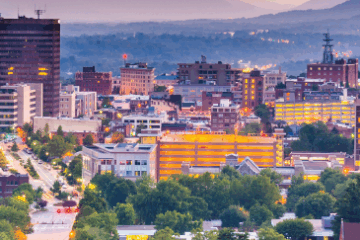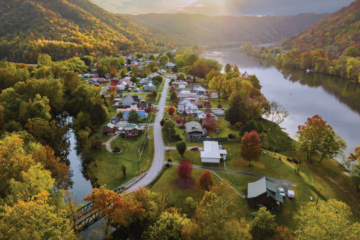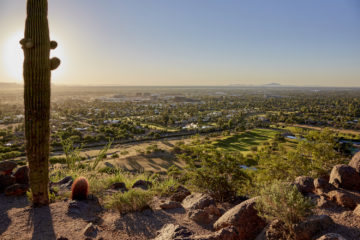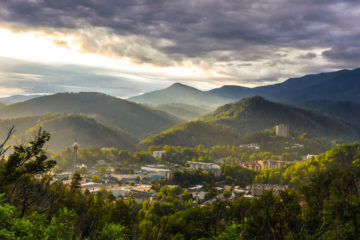
Immigration Gives Catholicism a Boost in the United States
Date
April 15, 2008
Author
(April 2008) Results from a new U.S. report by the Pew Forum on Religion and Public Life indicate that more than one-fourth of U.S. adults have left their childhood faith to join another religion or are no longer affiliated with any religion.
The drop in religious affiliation has affected some groups more than others. While some world religions such as Islam and Hinduism have experienced a boom in the United States in recent years, Catholicism has been hit the hardest by a significant drop in membership over the life course.
Yet with 62 million adherents, Catholics remain the single largest religious group in the United States. Long-term trends from the General Social Survey, from 1972 through 2006, point to a decline in Protestant religions but show remarkable stability in the proportion of Catholics in the population.
What explains the resilience of the Catholic Church in the face of declining membership over a lifetime? New immigrants arriving in the United States—many Catholics from Latin America—have helped offset the decline in religious affiliation among the U.S.-born population. Figure 1 shows the parallel growth in the U.S. Catholic and Latino population between 1970 and 2000.
Figure 1
U.S. Hispanic/Latino and Catholic Populations, 1970 to 2000
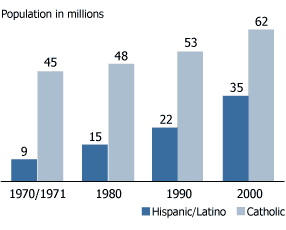
Sources: U.S. Census Bureau and Glenmary Research Center.
Although birth data are not available by religion, it is likely that the relatively high fertility rates among Latino women have also contributed to the recent growth of the U.S. Catholic population—especially for younger age groups. According to the Pew report, 45 percent of Catholics ages 18 to 29 are Hispanic/Latino, compared with 12 percent of Catholics ages 70 and older.
The Glenmary Research Center, which collects decennial data on religious congregations and “adherents” for the 50 states and the District of Columbia, reports that Catholics are one of the fastest-growing denominations in the country.1 Between 1990 and 2000, the number of Catholic adherents increased by more than 16 percent, while membership in many Protestant Churches declined. The Pentecostal and Mormon Churches are notable exceptions (see Figure 2).
Figure 2
Percent Change in Religious Adherents Among Major Denominations, 1990 to 2000 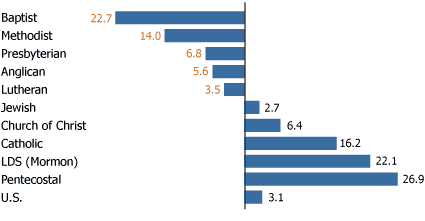
Source: Glenmary Research Center.
Catholicism Increasing Fastest in the South and West
Immigration trends have led to a shift in the geographic distribution of Catholics. While many Catholic congregations in the northeastern United States are struggling with population loss and declining membership, southern and western states—where domestic and international migrants are most highly concentrated—have seen large increases over the past decade. The map below highlights the states with the fastest growth or decline in Catholic adherents during the 1990s.
Figure 3
Percent Change in the Catholic Population in U.S. States, 1990 to 2000
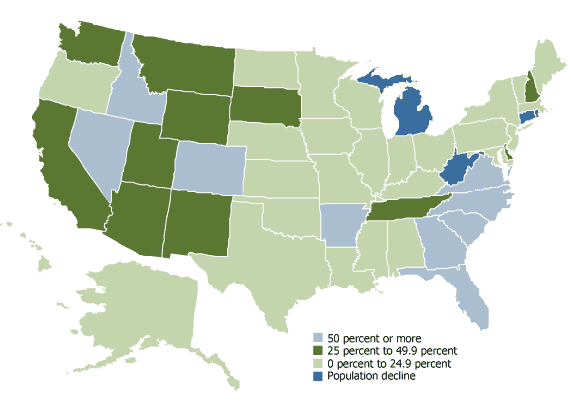
Source: Glenmary Research Center.
The Catholic migration to states in the South and West affects not just the geographic distribution of people but also the location of churches. During the 1990s, 413 Catholic congregations in the Northeastern United States2 closed shop and opened new churches, including 132 in the Southwest3 and 54 in the Southeast, where it’s easier to recruit new members. In 2006, the Catholic Church appointed the first Roman Catholic cardinal in the state of Texas, recognizing the growth of the Catholic faithful from Mexico and Central America.
For newcomers to the United States, religion can be a powerful force that connects them to family and neighbors, gives them a sense of community with people who speak the same language, and offers them cohesiveness and a strong social network they can fall back on in times of trouble.
America’s Religious Melting Pot
While most foreign-born residents (74 percent) are Christian, there has been an increase in people who belong to non-Western religions such as Buddhism, Islam, and Hinduism during the past decade. According to the Pew report, nearly half of the U.S. foreign-born are Catholic (mostly immigrants from Latin America), one-fourth are Protestant, and 16 percent have no religious affiliation. About 3 percent of the foreign-born are Hindu, while Buddhists and Muslims account for less than 2 percent each of the foreign-born population. These numbers may seem small but they are more than double the proportions of Hindus, Buddhists, and Muslims in the U.S.-born population.
Questions about religious affiliation seem to bubble to the surface during presidential election years. During the 2000 and 2004 elections, evangelical voters played a pivotal role in swinging the vote toward Republicans. This year, much attention has focused on Catholics (including Latinos and non-Hispanic whites), and Protestants in key battleground states, where candidates in both major parties have been pressed to express their religious convictions. As the racial and ethnic landscape continues to change, candidates will increasingly need to reach out to people representing a diversity of religious traditions.
Nadwa Mossaad is a research associate at the Population Reference Bureau. Mark Mather is associate vice president of domestic programs at the Population Reference Bureau.
References
- Adherents include all members, including their children and the estimated number of other participants who are not considered members; for example, the baptized, those not confirmed, those not eligible for communion, and those regularly attending services.
- Pennsylvania, New York, Maine, New Hampshire, Vermont, Massachusetts, Rhode Island, Connecticut, and New Jersey.
- New Mexico, Arizona, Texas, Nevada, Utah, Colorado, Oklahoma, and California.

